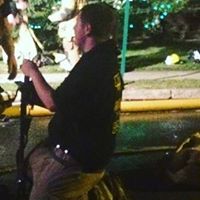Sean C Wyatt
age ~53
from Chicago, IL
- Also known as:
-
- Sean Christopher Wyatt
- Phone and address:
-
2431 N Francisco Ave, Chicago, IL 60647
(312)5433329
Sean Wyatt Phones & Addresses
- 2431 N Francisco Ave, Chicago, IL 60647 • (312)5433329
- Ypsilanti, MI
- 18329 13 Mile Rd, Southfield, MI 48076
- 6515 Yale St, Westland, MI 48185
- 824 Beacon St, Boston, MA 02215
- Saint Louis, MO
- Albuquerque, NM
- 7346 Perrinsville Ct, Westland, MI 48185
Us Patents
-
System And Method For Diesel Particulate Filter Regeneration
view source -
US Patent:7484503, Feb 3, 2009
-
Filed:Jun 25, 2007
-
Appl. No.:11/767732
-
Inventors:Sean C. Wyatt - Chicago IL, US
Paul L. Berke - Chicago IL, US
Felicia V. Centeno - Chicago IL, US -
Assignee:International Engine Intellectual Property Company, LLC - Warrenville IL
-
International Classification:F02B 47/08
F02M 25/07 -
US Classification:12356816, 60295, 60274
-
Abstract:A method for regenerating a diesel particulate filter () in the exhaust system () of an engine (). When a request to regenerate the device is issued, a control system () operates the engine to begin conditioning exhaust. The conditioning process comprises a warming phase that occurs prior to initiation of regeneration and a heating phase during which regeneration can occur. During the process, data related to the warming phase and the heating phase is evaluated. The engine is operated to terminate the process prior to having reduced the amount of trapped particulate matter to a target amount when evaluation of the data discloses that the process should be terminated.
-
System And Method For Calculating Loading Of A Diesel Particulate Filter By Windowing Inputs
view source -
US Patent:7698888, Apr 20, 2010
-
Filed:Feb 6, 2007
-
Appl. No.:11/671830
-
Inventors:Sean C. Wyatt - Chicago IL, US
-
Assignee:International Engine Intellectual Property Company, LLC - Warrenville IL
-
International Classification:F01N 3/00
-
US Classification:60295, 60274, 60286, 60297, 701102, 701114, 700271
-
Abstract:An algorithm () in an engine control system () develops data indicative of pressure across a DPF () as a function of time and data indicative of flow rate through the DPF as a function of time, calculates derivatives () () with respect to time of the data, processes the derivatives () to confirm validity of a calculation of particulate loading of the DPF (load_pf) when a result of processing the derivatives discloses the absence of transient conditions in the DPF that would prevent the calculation from being valid and to not confirm validity of a calculation of particulate loading of the DPF when a result of processing the derivatives discloses the presence of transient conditions in the DPF that would prevent the calculation from being valid.
-
Method And System For Increasing The Estimation Accuracy Of Cam Phase Angle In An Engine With Variable Cam Timing
view source -
US Patent:20030079701, May 1, 2003
-
Filed:Nov 1, 2001
-
Appl. No.:09/682930
-
Inventors:Bradley Riedle - Northville MI, US
Giuseppe Suffredini - Shelby Township MI, US
Jeffrey Doering - Canton MI, US
Sean Wyatt - Detroit MI, US -
International Classification:F01L001/34
-
US Classification:123/090150
-
Abstract:A system and method for determining an estimation of actual cam phase angle of increased accuracy are based on an observed cam phase angle derived from a cam phase sensor and a predicted cam phase angle derived from a desired or commanded cam phase angle. The estimated cam phase angle is used in the electronic control unit in computing desired settings for engine variables which depend on cam phase angle.
-
Method For Urea Injection Control
view source -
US Patent:20110036078, Feb 17, 2011
-
Filed:Aug 14, 2009
-
Appl. No.:12/541446
-
Inventors:Vadim Strots - Forest Park IL, US
Sean C. Wyatt - Chicago IL, US -
Assignee:International Engine Intellectual Property Company , LLC - Warrenville IL
-
International Classification:F01N 9/00
-
US Classification:60287
-
Abstract:A urea injection control system () for a vehicle having an exhaust line () in fluid communication with a SCR catalyst () and a urea injector () for injecting urea into the exhaust line includes a controller () for controlling the flow rate of urea injection at the urea injector. The controller () compares an optimum urea flow rate () with a flexible urea flow rate () determined by a flexible flow rate calculator. The controller () selects the minimum value of the optimum urea flow rate () and the flexible urea flow rate (), and controls the urea injector () to inject urea at the minimum value.
-
Turbocharger Control
view source -
US Patent:20130195614, Aug 1, 2013
-
Filed:Jan 31, 2013
-
Appl. No.:13/756522
-
Inventors:International Engine Intellectual Property Company, LLC - Lisle IL, US
James Rynold Popp - Oak Creek WI, US
Sean Christopher Wyatt - Ann Arbor MI, US
Michael James McNulty - Lombard IL, US
Jose Antonio Rodriguez - Chicago IL, US
Jeremy Grant Schipper - Chicago IL, US -
Assignee:International Engine Intellectual Property Company, LLC - Lisle IL
-
International Classification:F04D 15/00
-
US Classification:415 1
-
Abstract:A method of controlling a variable geometry turbocharger is provided. A predefined desired boost pressure of a turbocharger is obtained from a memory. A predefined desired mass flow rate in an intake manifold of an engine is obtained from the memory. A theoretical amount of power required by the turbocharger to generate the desired boost pressure and the desired mass flow rate is calculated. An actual mass flow rate in the intake manifold is determined. An actual amount of power required by the turbocharger to generate the desired boost pressure and the actual mass flow rate is calculated. At least one adjustable vane of the turbine of the turbocharger is adjusted to allow the theoretical amount of power required of the turbocharger to generally equal the actual amount of power by adjusting the boost pressure.
-
Nox Control
view source -
US Patent:20130197785, Aug 1, 2013
-
Filed:Jan 31, 2013
-
Appl. No.:13/756232
-
Inventors:International Engine Intellectual Property Company, LLC - Lisle IL, US
Michael James Miller - Mt. Prospect IL, US
Matthew Joseph Seiberlich - Libertyville IL, US
James Rynold Popp - Oak Creek WI, US
Sean Christopher Wyatt - Ann Arbor MI, US
Michael James McNulty - Lombard IL, US
Jose Antonio Rodriguez - Chicago IL, US
Jeremy Grant Schipper - Chicago IL, US -
Assignee:International Engine Intellectual Property Company , LLC - Lisle IL
-
International Classification:F02D 43/04
-
US Classification:701104
-
Abstract:A method of controlling an engine based upon airflow is provided. A request for a desired torque output of the engine is received. A first amount of fuel required to generate the desired torque is retrieving from a memory. An amount of airflow required to combust the fuel required to generate the desired torque at a predefined air/fuel ratio is calculated. A first amount of EGR required to produce a predefined amount of NOx emissions is calculated. The amount of airflow required to the first amount of EGR required is added. The total of the airflow and the first amount of EGR are compared to a volume available in a cylinder. At least one of the first amount of fuel delivered and the first amount of EGR provided is modified when the total of the airflow and the EGR exceeds the total volume available in the cylinder.
-
Apparatus And Method For A Mobile Water-Based Cooking System
view source -
US Patent:20220313014, Oct 6, 2022
-
Filed:Mar 30, 2021
-
Appl. No.:17/216954
-
Inventors:- Clark NJ, US
Alphonse A. Lanza - River Edge NJ, US
George Meyerle - Brookfield CT, US
Sean Christopher Wyatt - Chicago IL, US -
International Classification:A47J 36/32
G05B 15/02
B60K 35/00
A47J 36/06
A47J 27/18
A47J 27/12 -
Abstract:A water-based cooking apparatus onboard a vehicle includes a cooking bay and a controller. The cooking bay can be sealed with a lid so that water does not escape the cooking bay when the vehicle is in motion. The controller receives, from a computing device onboard the vehicle, cooking instructions including commands operable to perform one or more of filling the cooking bay with water, setting a temperature for the cooking bay, and adjusting a salinity of water in the cooking bay. The computing device can display cooking instructions on a display and can send status reports to a remote command center.
Resumes

Printcity.com - Your Print And Promo Experts
view sourcePosition:
Owner at PrintCity.com
Location:
Dallas, Texas
Industry:
Printing
Work:
PrintCity.com - Dallas, Texas since 2008
Owner
Owner
Education:
TCU

Sean Wyatt
view sourceFlickr

Sean Wyatt Campbell
view source
Sean Wyatt
view source
Sean Wyatt
view source
Sean Wyatt
view source
Sean Michael Wyatt
view source
Sean Wyatt
view source
Sean Geoffrey Wyatt
view source
Sean Wyatt
view sourceClassmates

Sean Wyatt
view sourceSchools:
Reed High School Sparks NV 1989-1993
Community:
Pamela Johnson, Robin Kesterson, Karen Stratton, David Moser

Sean Wyatt
view sourceSchools:
Surrattsville Elementary School Clinton MD 1976-1979, Surrattsville Middle School Clinton MD 1979-1981
Community:
Derek Jackson

Sean Wyatt
view sourceSchools:
York Community High School Elmhurst IL 1980-1984

Sean Wyatt
view sourceSchools:
Nottingham Country Elementary School Katy TX 1983-1988, Memorial Parkway Junior High School Katy TX 1989-1992

Nottingham Country Elemen...
view sourceGraduates:
Phillip Song (1992-1996),
Nicolette Zulli (2000-2004),
Amanda Abito (1994-1998),
Sean Wyatt (1983-1988)
Nicolette Zulli (2000-2004),
Amanda Abito (1994-1998),
Sean Wyatt (1983-1988)

Glenarden Woods Elementar...
view sourceGraduates:
Sean Wyatt (1972-1975),
Tele Rountree (1996-1996),
Nancy Julius (1977-1979),
Yvette Edmonds (1980-1983)
Tele Rountree (1996-1996),
Nancy Julius (1977-1979),
Yvette Edmonds (1980-1983)

Surrattsville Elementary ...
view sourceGraduates:
Michael Goldstein (1969-1974),
Bruce Walker (1961-1965),
Melanie Rivoire (1974-1981),
Sean Wyatt (1976-1979),
Barry Koontz (1965-1972)
Bruce Walker (1961-1965),
Melanie Rivoire (1974-1981),
Sean Wyatt (1976-1979),
Barry Koontz (1965-1972)

Memorial Parkway Junior H...
view sourceGraduates:
Sean Gillette (1995-1998),
Kristen Grace (1991-1995),
Sean Wyatt (1989-1992),
Jeremy Henry (1989-1992),
Jennifer Waterhouse (1983-1986)
Kristen Grace (1991-1995),
Sean Wyatt (1989-1992),
Jeremy Henry (1989-1992),
Jennifer Waterhouse (1983-1986)
Plaxo

Sean Wyatt
view sourceState of Louisiana - GOHSEP
Youtube
Googleplus

Sean Wyatt
Work:
Kingston University
Education:
Kingston University - Photography, Oxford Brookes University - Art and Design

Sean Wyatt
About:
Hello, I am a writer of "The Story of Omega".
Tagline:
A casual writer

Sean Wyatt
Relationship:
Single

Sean Wyatt

Sean Wyatt

Sean Wyatt

Sean Wyatt

Sean Wyatt
Myspace
Get Report for Sean C Wyatt from Chicago, IL, age ~53













